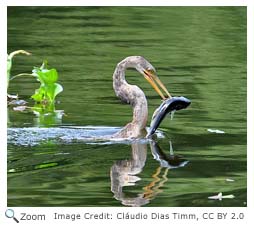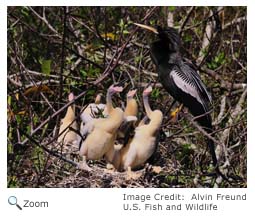Diet

Using its sharp bill, the anhinga spears fish, flips them in the air, and swallows them head-first! Sometimes, the anhinga spears a fish so hard that it has to return to shore with the fish still stuck on its bill. The anhinga bangs the fish against a rock to get it off its bill!
Life Cycle
The male anhinga courts the female by flying and gliding overhead. The male chooses a nesting site. Once a pair has formed, the male gathers sticks, leaves, and twigs for the nest. The female uses the materials the male gathers to build a platform nest in a tree. The nest is built 4-20 feet above the ground or water.
 The female lays 3-5 light blue eggs and both parents incubate the eggs for about a month. The chicks are blind and helpless when they hatch. Both the male and female feed them regurgitated food. The chicks fledge when they are six weeks old, but they stay with their parents for a few more weeks. Male and female pairs may mate for more than one year and often use the same nesting site.
The female lays 3-5 light blue eggs and both parents incubate the eggs for about a month. The chicks are blind and helpless when they hatch. Both the male and female feed them regurgitated food. The chicks fledge when they are six weeks old, but they stay with their parents for a few more weeks. Male and female pairs may mate for more than one year and often use the same nesting site.
Behavior
The anhinga is also known as the snakebird. When it swims, its body is submerged under the water. It stretches its head and neck flat out on the surface of the water. When its head and neck are stretched out, it looks like a snake is gliding through the water.